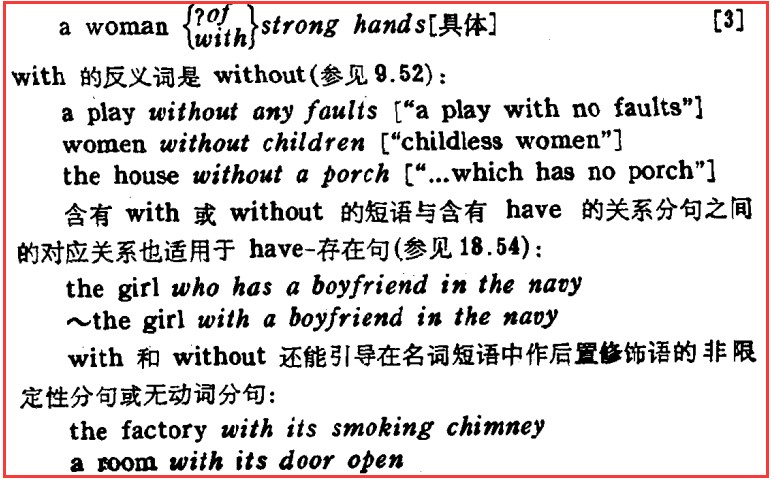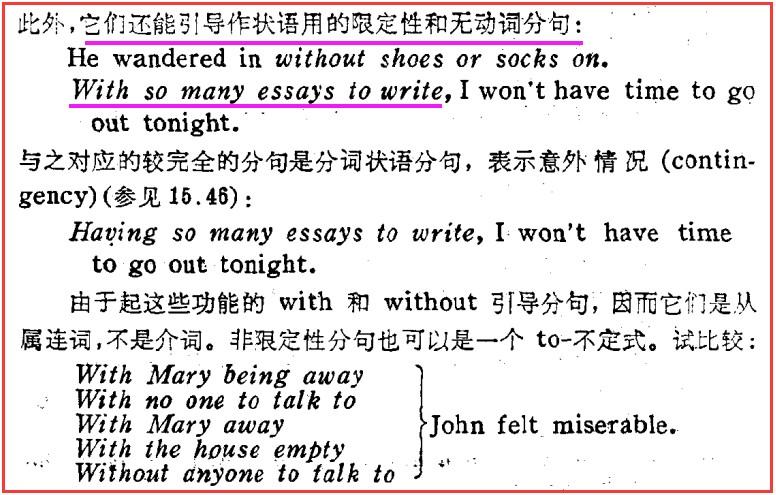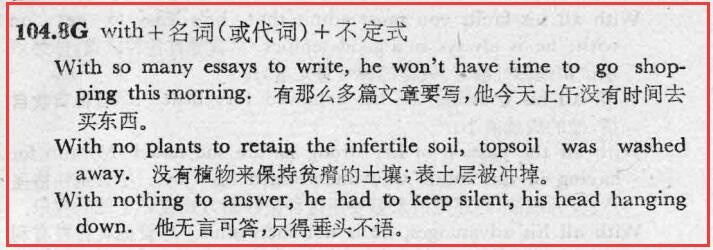10 with sth to do 是with复合结构还是普通的介词短语(不定式作定语)
看到前面有个网友提的一个问题:
https://www.cpsenglish.com/question/57108
With a lot of problems to settle, the president is having a hard time.
请问这里的 With a lot of problems to settle 是 with 复合结构(不定式为宾语补语)还是普通的介词短语(不定式作定语,修饰前面的名词)?
对于一个普通的 with sth to短语,如何判断它是 with 复合结构(不定式为宾语补语)还是普通的介词短语(不定式作定语,修饰前面的名词)?有什么标准和方法吗?
其它 8 个回答
网友可以读一下我对这个问题的解答:关于with复合结构和独立主格结构的问题 - 柯帕斯英语网 (cpsenglish.com)
如果觉得我的回答对您有用,请随意打赏。你的支持将鼓励我继续创作!

看了原链接,先站个队,个人赞同黎老师的解答。我觉得,对于本站资深网友来说,这个问题不是问题了吧?
problems to settle这种不定式结构在《剑桥英语语法》中称为“悬空(反射)不定式(hollow infinitive)”,即不定式短语中的及物动词或动词短语后不跟宾语,呈悬空状态,而这个宾语可以在前面找到,这句中settle的宾语是 problems。既然题干中的with短语中不定式和名词间是动宾关系,二者不构成介词宾语和宾语补足语关系,所以是不定式作定语。再者,这个with短语中不定式的逻辑主语是the president(补全的话: With a lot of problems for the president/him/her to
settle)而不是problems。
with独立结构中,除了极少数情况下being必须加上,大多数情况下逻辑主语后的being可省可不省,无being的未必是with复合结构,但有being的一定是with复合结构,即“with+宾语+现在分词
being”复合结构。如果这句话中的with短语变为With a lot of problems being to settle,那么自然就是with复合结构了。比如前几天在知乎上看到的这句:Code-named "Operation Overlord”, it was the
largest combined sea, air and land operation in history, the aim being to free north-west
Europe from German occupation. The aim 前可以加with。
其实把框架搭清楚就很好理解这个问题的实质是什么。
1.With a lot of problems to settle, the president is having a hard time.
这里的with结构是否是带介词+不定式的独立主格结构?可以这么说:带介词with的不定式结构通常都不会理解成独立主格结构,网友为什么会理解成独立主格结构我觉得可能是某种臆想的产物。值得注意的是历史上“不带介词的独立主格结构确实可以有不定式存在的”。这种结构现在很少见了,在古英语和在爱尔兰比较常见。这个说法可以参考Curme的著作“Syntax(A grammar of the English Language v3)”第154页:
In older English, and sometimes still, we find the prepositional infinitive used here as predicate: ‘ I send you today three fourths of the sum agreed upon between us, the rest to follow within a month.’
In popular Irish, the infinitive has come into wide use here, so that it can be employed in every kind of subordinate clause, in conditional clauses, tem poral clauses, etc.: (conditional clause) ‘ It would not be for honor she to go without that much’ (Lady G regory, McDonough’s Wife).
如果With a lot of problems to settle改成With a lot of problems settled就是带介词with的独立主格结构,但是意义不同,同主句the president is having a hard time意思也不匹配。
既然不理解成独立主格结构,那要如何理解?大家都已经说的很多了,我提一个理解思路,可以琢磨琢磨:
With a lot of problems to settle和With a lot of problems to be settled的区别在哪?这个问题又回到不定式作后修饰时表主谓关系和动宾关系时的区别是什么?一般动宾关系绝大多数情况下表情态意义,暗含动作还未发生。而主谓关系(被动也是主谓关系)一般不表示情态意义,具体什么意义只能根据上下文来判断。举几个这样的例子看看:
2.With the new methods still to be tried it cannot be said what results may be obtained. [Since the new methods are still to be tried...].
3.With every desire to be methodical, I am going to find it difficult to subdivide my subject tidily and compactly.
4.With a number of seats still to be announced, they are certain to have at least six seats over the 218 required for an absolute majority.(Present-day English syntax第221页)
With a lot of problems to settle, the president is having a hard time.
解答:关于with+名词+其它 的结构中,如果“名词+其它”属于“宾语+宾补”结构,那么就是with的复合结构,反之,则不是with的复合结构,而且是其它形式的结构。然后我们再回过来看以上结构with a lot of problems to settle,很显然a lot of problems to settle这个结构中的“a lot of problems” 和"to settle"不具备“宾语+宾补”特点,所以不可以分析为复合结构。而是一个不定式to settle作后置定语,修饰名词a lot of problems结构
【1】with a lot of problems to settle 为介词with+名词构成介词短语作原因状语。不定式逻辑主语时后面句子主语 the president。
备注(1):如果不定式to settle逻辑主语是句子主语president,则不定式用主动结构“to settle”作定语修饰前面名词problems。
备注(2):如果不定式to settle逻辑主语是不是句子主语president,则不定式用被动结构“to be settled”作定语修饰前面名词problems。
【2】I have a lot of work to do ,(a lot of work to do和上面结构一样,都是名词+不定式作后置定语)
备注(1):如果不定式to do逻辑主语是句子主语I,则不定式用主动结构“to do”作定语修饰前面名词work。
备注(2):如果不定式to do逻辑主语是不是句子主语I,则不定式用被动结构“to be done”作定语修饰前面名词work。
(1)I have a lot of work to do.(自己来做很多工作)
(2)I have a lot of work to be done.(委托别人来做很多工作)
如果觉得我的回答对您有用,请随意打赏。你的支持将鼓励我继续创作!

- 15 关注
- 9 收藏,4974 浏览
- 米佳佳 提出于 2022-04-13 12:42
相似问题
- with复合结构有哪些类型 1 回答
- with复合结构中的宾补用过去分词与用现在分词被动式的区别 1 回答
- with复合结构和with引导的状语都可以做何种类型的状语 1 回答
- with sth 后面的现在分词的理解与分析 1 回答
- 关于with加宾语加宾补的疑惑 2 回答
- with复合结构疑惑 1 回答
-
 《高考英语备考1号·速效编》
《高考英语备考1号·速效编》
-
 《高考英语备考1号·写作编》
《高考英语备考1号·写作编》
-
 《高中英语晨读晚记》
《高中英语晨读晚记》
-
 《高中英语错题笔记》
《高中英语错题笔记》
-
 《零起点考大学英语》
《零起点考大学英语》
-




